Gamla Stan (Old Town) is the historic heart of Stockholm. It is a favorite with tourists thanks to the appealing medieval streets and the many sights, in particular the Royal Palace.
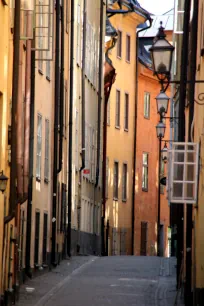
Many of the narrow, cobblestone alleys in Gamla Stan are car free, making a walk around the Old Town a pleasure. Plenty of shops, cafés and restaurants ensure the area is always alive. But there are also several idyllic squares and peaceful streets where visitors can admire the historic charm of Stockholm’s medieval center.
Gamla Stan officially comprises three of Stockholm’s fourteen islands – Riddarholmen, Stadsholmen and Helgeandsholmen – but when people mention Gamla Stan, they usually think of Stadsholmen, the largest of the three.
History

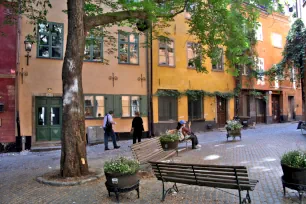
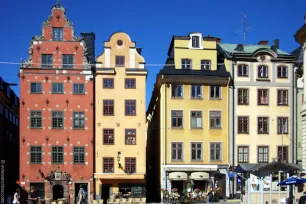
For many centuries, the city of Stockholm was confined to the island of Stadsholmen. Until the nineteenth century, when the rest of Stockholm was still mostly rural, it was simply called Staden (the city). Later it became known as the Staden mellan broarna (The city between the bridges) and only since 1980 has it been called Gamla Stan or Old Town.
Stockholm started to develop in the thirteenth century, under the protection of the castle that was built by the city’s founder Birger Jarl. By the end of the thirteenth century, it had become Sweden’s largest city. From the fourteenth up to the seventeenth century, German merchants made Stockholm an important trade center. They built many patrician houses, churches and warehouses on Stadsholmen.
Many of the magnificent palaces and houses in Gamla Stan – including the Royal Palace – were built during the seventeenth and early eighteenth centuries, when Sweden was one of Europe’s most powerful nations.
Sights
Gamla Stan is packed with interesting historical sights and museums. The most famous attraction is the Royal Palace, built in the early eighteenth century at the site of the former castle. Nearby is one of the oldest buildings in Gamla Stan, the Storkyrkan (Great Church), Stockholm’s cathedral, originally built in the early fourteenth century.
Stortorget
Nearby is Stortorget, the central square and heart of Gamla Stan. Many tourists relax here on one of the benches at the square while admiring the colorful patrician houses.
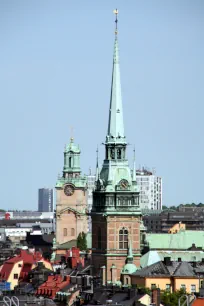
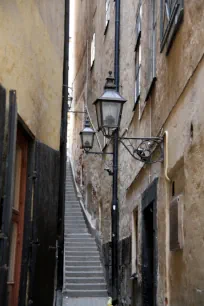
German Church
For centuries, this area was dominated by German merchants, and nowhere is this more obvious than at the Tyska Kyrkan (German Church), where visitors are greeted with German inscriptions.
Tyska Brinken (German Slope) connects the German Church with Västerlånggatan, an often crowded shopping street with plenty of souvenir shops. Today it is one of the main streets in Gamla Stan, but in the Middle Ages, it was a lakeside path just outside the city wall.
Parallel with Västerlånggatan runs Prästgatan, which ran just inside the city walls. The cobblestoned alley with pastel colored buildings is one of the most beautiful streets in the city. In the wall of one of the houses, at the corner of Kårkbrinken, you can see a runestone, which is believed to be about one thousand years old.
Mårten Trotzigs Grand
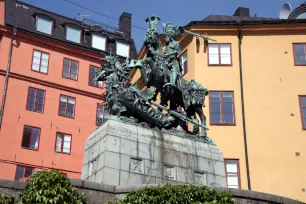
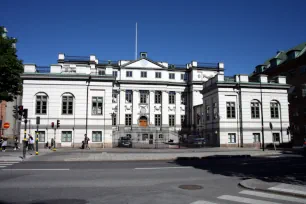
Towards the east, Prästgatan passes the steepest and most narrow street in Gamla Stan: Mårten Trotzigs Grand. The street, named after a German merchant, is only 90 cm wide (3 ft). After climbing the steps you end up at Järntorget (Iron Square), the site of the National bank until 1906 when it moved to Helgeandsholmen.
More Squares
There are several more interesting squares in Gamla Stan, and each has its own charm. Some of the more interesting include the small triangular Brända Tomten, which is surrounded by picturesque houses. The nearby Köpmantorget has a large statue of St. George and the dragon, a bronze replica of the famous wooden statue in the cathedral. Tyska Brunnsplan (German Well Square), yet another name that alludes to the many Germans who lived here, has a well shaped like a small temple.
Some of Gamla Stan’s most impressive buildings border Riddarhustorget, an uncharacteristically car-heavy square near Riddarholmen. Here are two magnificent seventeenth century buildings, the white Bonde Palace and the red-brick Riddarhuset, by many considered the most beautiful house in Stockholm.
Riddarholmen and Helgeandsholmen

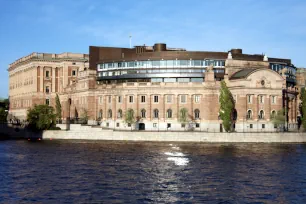
Several bridges connect Stadsholmen with the islands of Riddarholmen and Helgeandsholmen.
In the seventeenth century, the nobility started to build magnificent palaces on the small island west of Stadsholmen, which led to the name Riddarholmen – Knight’s Islet. Today very few people live here – less than one hundred – and there is not much activity here, there aren’t even any shops.
There are plenty of historic sights though, including several palaces as well as the Riddarholmen Church – home to tombs of Swedish kings, Birger Jarl’s Tower – a remnant of the defensive wall around the city – and the Evert Taube terrace, with a statue honoring singer and songwriter Evert Taube.
Helgeandsholmen, the smallest of the three islands that make up Gamla Stan, is dominated by the Riksdagshuset, the Swedish House of Parliament.
